Romance of a Gateway to Scotland
FAMOUS RAILWAY CENTRES - 6
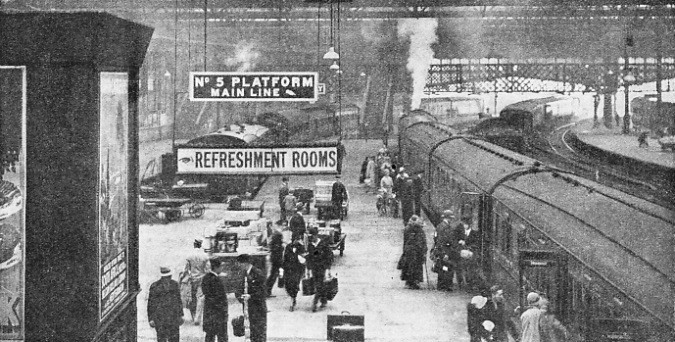
THE CITADEL STATION at Carlisle was formerly the meeting place of seven British railways, and was jointly owned by the Caledonian Railway and the LNWR. To-day the station is LMS property, although it is served also by the LNER. The above photograph illustrates the main line up platform. On the left are the bays used by the LNER trains for Newcastle and by local Midland Division trains for the Appleby direction.
IN the days before grouping, Carlisle shared with York the distinction of being the happiest of all happy hunting grounds for the railway enthusiast. The claims of York to popularity have already been dealt with, in the chapter on “York”. Claims of Carlisle to favour were even more marked. Six of Britain’s leading railways - three English and three Scottish - found a common meeting-place in the Citadel Station, together with one smaller company on the English side, making seven railways in all. Their owners painted their engines in black, red, blue, brown, and various shades of green, and further varied coach colours combined to produce a kaleidoscopic effect in rolling stock that was particularly attractive. More important than this, however, was the fact that this convergence of railways at the Border city of Carlisle made it a traffic centre of considerable note.
To-day, although the grouping of the railways in 1923 has reduced the seven railways using the station to two, and so has to some extent reduced its interest, as far as concerns locomotives and rolling stock, yet its importance as a railway centre remains undiminished. Indeed, that importance has in some ways become even greater than before, as, by the absorption of five of the pre-war companies into the London, Midland and Scottish group, this is now one of the most vital of all concentration points of LMS traffic.
Principal among the routes passing through Carlisle is the West Coast main line of the LMS. Carlisle marked the northern extremity of the late London and North Western Railway, 299 miles from Euston terminus in London, and the southern extremity of the Caledonian Railway, which extended for 240¾ miles northwards to Aberdeen. The first eight or nine miles of the Caledonian main line were in England. At Carlisle the black engines of the LNWR were changed for the cobalt-blue machines of the Caledonian. These two companies jointly owned the Citadel Station, and the other five railways using it entered by means of “running powers” over either North Western or Caledonian tracks. As both these companies have been absorbed in the LMS, the station is now exclusively LMS property, and LNER trains are admitted by “running powers”.
Next in importance was the Midland Railway, whose main line from St. Pancras, 309 miles long by the shortest route, also found its northern extremity in Carlisle. Curiously enough, Midland trains had to pass over a short length of North Eastern track, for half a mile from Petteril Bridge Junction, into the joint station, because the late North Eastern Railway, coming across the Pennines from Newcastle-on-Tyne, was the first railway to reach Carlisle in 1838, the Midland not arriving until 1875.
The other English railway entering Carlisle, and less well known to the average reader, was the Maryport and Carlisle. This railway, although its main line, to Maryport, was only twenty-eight miles in length, was also of historic note, having been opened in 1845. It formed the chief link from the north with the isolated London and North Western group of lines in West Cumberland, connecting Maryport with Workington and Whitehaven - an important coal-, iron-, and steel-producing district.
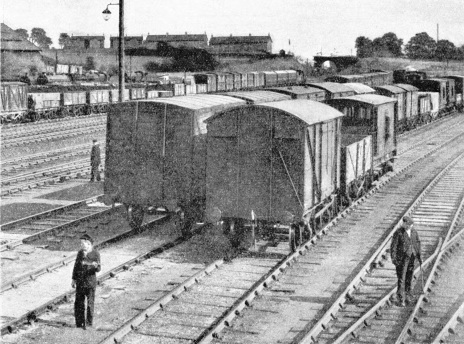
KINGMOOR. YARD, two miles north of Carlisle, is used for the marshalling of freight trains. In summer the down “Royal Scot” runs from Euston to Kingmoor, a distance of 301.1 miles, without a stop. The stop at Kingmoor is made for the purpose of changing engines.
Through trains were run between Carlisle and Whitehaven by this route. Now that both the Maryport and Carlisle and Furness Railways have come within the LMS group, a regular through service is run right round the north-west coast, connecting Carlisle with Maryport, Workington, Whitehaven, Barrow-in-Furness, Carnforth, and Lancaster.
The two other railways entering from the north side were the Glasgow and South Western and North British, and both were in alliance with the Midland. The forrner, from Glasgow, Kilmarnock, and Dumfries, joined the Caledonian at Gretna Junction, eight and three-quarter miles to the north. The latter, coming from Edinburgh south-westwards through Galashiels, Hawick, and the “Waverley” country of the Scott novels, crossed the Caledonian line at Kingmoor, two miles north of Carlisle, and, describing a wide sweep to the west, picked up a branch from Silloth. It then doubled back eastwards, joining the Caledonian three-quarters of a mile north of the Citadel Station. The Silloth branch was one of the few English lines that were owned by a Scottish company. Most through Midland expresses from the south found two different locomotives awaiting them on arrival at Carlisle - a Glasgow and South Western 4-6-0 to take the main Glasgow portion of the train forward, and a North British “Atlantic” for the Edinburgh portion. Joint rolling stock was used for these services, that for Glasgow, being lettered “M & GSW”, and that for Edinburgh and Aberdeen “M & NB”, in accordance with the initials of the owning companies. A comparable practice obtained on the West Coast Route; the joint coaches of the London and North Westem and Caledonian Railways were inscribed “WCJS”, to indicate “West Coast Joint Stock”.
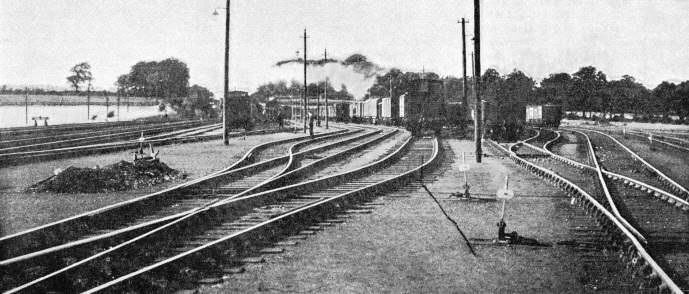
NEAR CARLISLE. Another view of the LMS Kingmoor Yard, where goods trains are made up. At Kingmoor are the LMS engine sheds that house locomotives working LMS trains north of Carlisle.
The Citadel Station at Carlisle is far from breaking any records in size, though it is big enough for the business which it has to transact, except, perhaps, at busy, week-ends in the height of the season, when the working becomes somewhat difficult. It consists of one long and broad island platform, and one platform - the main up platform - adjoining the station buildings, making three platforms for the through services. Between the main up platform and the island, two additional centre lines are provided, with cross-overs to and from the platform lines at the middle of the station. This facilitates engine movements and the marshalling of stock on and off the trains. On the west of the island four further tracks are provided for the storage of carriages, within the “all-over” roof which covers the station from one side to the other. It is curious that this space has not been utilized to provide an additional through platform on the down side, which at times is badly needed, as space could probably be found at a short distance from the station for the storing of coaching stock.
There are several bay platforms at Carlisle. The south end of the island platform has a single bay, used chiefly by trains for the Maryport and Whitehaven direction. Two platforms are let into the south end of the main up platform, used by LNER trains for Newcastle, and by local Midland trains for the Appleby direction. At the north encl of the same platform there are two similar bay platforms, used mainly by local LNER trains for the Silloth line and for the Hawick direction. The west side of the island is used exclusively for down trains, but the east side is used by up and down trains indiscriminately, as traffic conditions require. The station thus comprises three main through platforms and five short bays.
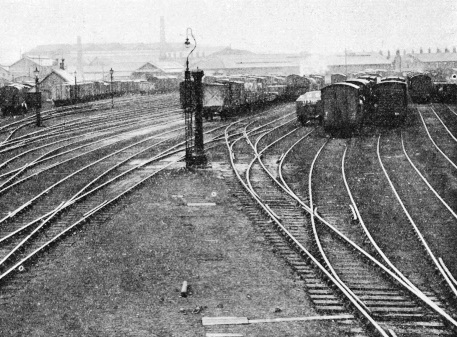
DURRAN HILL YARD lies about a mile and a quarter south-east of the Citadel Station. Apart from the marshalling yards, the engine-sheds of the Midland Division are also situated here.
The goods lines have been carried on an independent location well to the west of the station, directly connected by a maze of burrowing junctions with big marshalling yards of the LMS Western Division at Upperby, and with those of the Midland Division and LNER at Durran Hill. These freight lines rejoin the main line three-quarters of a mile to the north of the station, and freight and passenger traffic are thus kept distinct. It is rarely that a freight train is seen to pass through Citadel Station.
All engines of outward-bound express trains from Carlisle, whether to the north or to the south, have heavy climbs ahead. The station itself lies but little above sea-level, but mountainous country is no great distance away. The ascent southwards of the West Coast main line is plain to see from the station platform, immediately beyond which it begins. For the first four and three-quarter miles to Wreay, it rises, out of the station, at an inclination of 1 in 110 for a short distance, and then at 1 in 131. From Wreay it continues on rather flatter grades, but with little intermission until Penrith has been passed, after which come seven toilsome miles at 1 in 125 to Shap Station. Two miles farther on is Shap Summit, and the Westmoreland hills, thirty-one and a quarter miles from Carlisle and 915 feet above the sea.
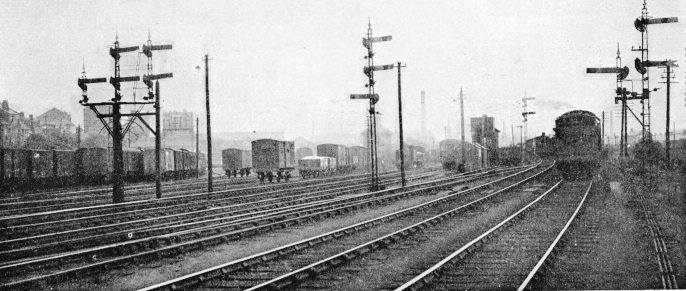
BURROWING JUNCTIONS connect the goods line near Carlisle with big marshalling yards 6f the Midland Division of the LMS and of the LNER at Durran Hill. This illustration gives an idea of the large area covered by the yards adjacent to the north end of the station.
Northwards from Carlisle the West Coast trains have a good start, with a downhill inclination, until they have crossed the Solway, near Floriston, but after that they also have hard “collar-work” ahead for many miles. Between Gretna and Lockerbie the adverse grades are not steeper than 1 in 200; and, after the level thirteen and a half miles from Mile Post 22 past Lockerbie, the approach to Beattock is still no steeper. But from Beattock to Beattock Summit, all but fifty miles north of Carlisle, there is a formidable ten-miles climb into the mountains, the whole of it between 1 in 69 and 1 in 88.
The Glasgow and South Western Section, with a course farther to the west, does not rise above 615 feet, and the train is well beyond Dumfries, and thirty-three miles from Carlisle, before serious climbing begins.
W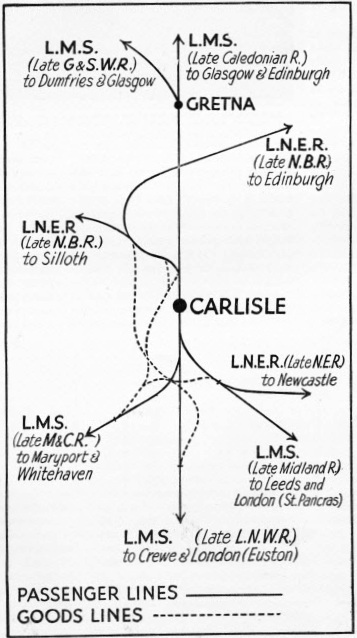 orse than any of these, however, is the task set to engines of Midland Division trains leaving Carlisle for the south. In the forty-eight and three-quarter miles to Ais Gill Summit, in Westmorland, they have to mount to an altitude of 1,169 feet above the sea. Out of Carlisle there is a fairly steep rise for seven miles, mostly at 1 in 132; but beyond that the grades are broken. It is not until near Ormside, two miles beyond Appleby, that climbing recommences in earnest, most of the ensuing fifteen miles being as steep as 1 in 100.
orse than any of these, however, is the task set to engines of Midland Division trains leaving Carlisle for the south. In the forty-eight and three-quarter miles to Ais Gill Summit, in Westmorland, they have to mount to an altitude of 1,169 feet above the sea. Out of Carlisle there is a fairly steep rise for seven miles, mostly at 1 in 132; but beyond that the grades are broken. It is not until near Ormside, two miles beyond Appleby, that climbing recommences in earnest, most of the ensuing fifteen miles being as steep as 1 in 100.
This matter of gradients is stressed because of the frequency with which express trains were formerly seen to leave Carlisle, especially for the south, with two engines. The pilots assisted as far as Shap or Ais Giil, as occasion demanded, and were there detached. With the advent of more powerful locomotives, however, the practice of piloting is being steadily reduced.
THE IMPORTANCE OF CARLISLE as a through station is illustrated
by this diagram, which shows the station as a focal point for many
main-line routes.
One of the two LNER routes leaving Carlisle - the “Waverley Route” to Edinburgh - is the most arduous of all those spreading fanwise from the border city. It continues north-eastwards, with one or two short ascents, through Longtown to Newcastleton, twenty-four miles away. From there an exceptionally severe climb winds uninterruptedly at 1 in 75 for nine miles up into the Lowland hills, past Riccarton Junction to Whitrope Summit, 880 feet above sea-level. From this wild and windswept spot the line drops with equal steepness to Hawick, and, crossing the valleys of the Tweed and Teviot to Galashiels, starts climbing again, until at Falahill it has topped 900 feet above sea-level. From Falahill the descent to Edinburgh is largely, inclined at 1 in 70. Fortunately the “Pacifics” now work over this route, and are able to handle 400-tons trains from Carlisle to Edinburgh without assistance.
The mention of “Pacifics” is a reminder of the fact that up to the present Carlisle has been, and still is, the only station in Great Britain at which the “Pacific” locomotives of the LNE and LMS Railways can be seen side by side. The lighter trains over the “Waverley Route” are generally headed by “Shire” class three-cylinder 4-4-0 locomotives. As to the Newcastle and Carlisle line, engines of all descriptions are seen on the passenger trains, including various kinds of 4-4-0’s and occasional two-cylinder and three-cylinder “Atlantics” of the late North Eastern Railway, ex-North British 4-4-0’s, standard “Shire” and “Hunt” 4-4-0’s, and, rarely, “Pacifics” on “running-in” duties after overhaul. Diesel-electric and other experimental engines are also seen at times.
Standardization is gradually reducing the varieties of LMS locomotives seen in Carlisle. In the earlier days of LMS history, four-cylinder 4-6-0 “Claughtons” and the larger four-cylinder 4-6-0’s of the late Lancashire and Yorkshire type were used on the principal trains to the south, and three-cylinder 4-4-0 Midland compounds on the Midland Division trains. Glasgow and South Western 4-6-0’s - engines of moderate dimensions - took the Midland trains forward, and Caledonian 4-4-0’s and 4-6-0’s took those off the London and North Western line. The nightly departure for Glasgow of the inside-cylinder Caledonian 4-6-0 “Cardean” - at the time of her construction in 1903 the most powerful express locomotive in Great Britain - was formerly one of the principal events at Citadel. It was viewed by no small number of Carlisle’s citizens who made the station the goal of their evening walk. “Cardean” regularly hauled the beautiful train of twelve-wheeled coaches -predecessor of the “Midday Scot” - that had left London at two o’clock in the afternoon.
The first post-grouping development was an influx of Midland compound 4-4-0’s, which were then seen on practically all the trains to Glasgow by either route, as well on the Midland Division. Next came the “Royal Scot” 4-6-0’s, gradually displacing the “Claughtons” and the Horwich-built 4-6-0’s, and then the “Baby Scots”. Now the ubiquitous “Stanier” three-cylinder 4-6-0’s handle most of the Midland Division trains out of Carlisle, and share with the “Royal Scots” the bulk of the haulage from Carlisle to Glasgow and the north. One advantage of grouping is that engine workings over the two routes to Glasgow are freely intermixed, the same locomotive frequently going from Carlisle to Glasgow by the Caledonian route and returning by the Glasgow and South Western route, or vice versa.
Another advantage is seen in the through working of locomotives. Whereas in pre-war days every long-distance train passing through Carlisle changed engines, this is no longer true. There are now numerous through locomotive workings every day over the 243.3 miles from Crewe to Glasgow, and in the reverse direction; one of the latter is the “Night Scot”, which is the only regular passenger train throughout the year to pass through Carlisle without stopping. Many light engine movements to and from the engine sheds are thus avoided. This is a great advantage, as the lines over which these engines would pass are densely occupied with trains. Kingmoor sheds, which house all the locomotives working LMS trains northwards from Carlisle, are two miles to the north.
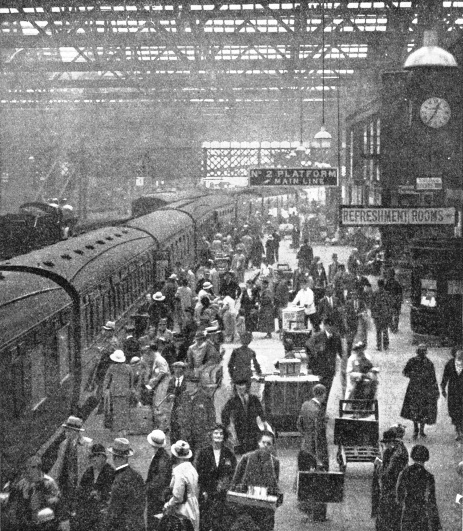
THE ARRIVAL OF AN LMS EXPRESS at the down platform at Citadel Station, Carlisle. By the most direct route, over the Western Section of the LMS, Carlisle is 299.1 miles from London. The best up train - the up “Royal Scot” - covers the distance in five and a half hours non-stop. Apart from the runs of the “Flying Scotsman” and of the down “Royal Scot” in summer, this is the longest regular non-stop run in the world. The down “Royal Scot”, on its winter schedule takes five hours forty-four minutes, with two stops- at Rugby and Crewe.
Upperby sheds, of the one-time London and North Western Railway, for engines working West Coast trains southwards, are a mile south of the station. The Midland engine-sheds are at Durran Hill, about a mile and a quarter out of Citadel Station on the Midland line; and the LNER sheds - those of the late North British Railway - are nearly a mile and a half out of Citadel.
Passenger train activity at Carlisle is more or less spasmodic. Comparatively little traffic originates at Carlisle, but much important traffic passes through. The times at which trains reach Carlisle are thus chiefly conditioned by the times at which they have left cities such as London, Leeds, Glasgow, and Edinburgh. For connexion purposes, many of these services are arranged to converge at Carlisle, and the result is to provide periods of intense activity in the station, alternating with periods when the untutored observer might almost imagine the railway to be asleep.
If we begin the day at breakfast-time, we shall find that, after trains of a more or less “semi-fast” order have left, at round about nine o’clock, for Glasgow, Edinburgh, and London, there is a wait of nearly three hours before the station once again shows signs of activity.
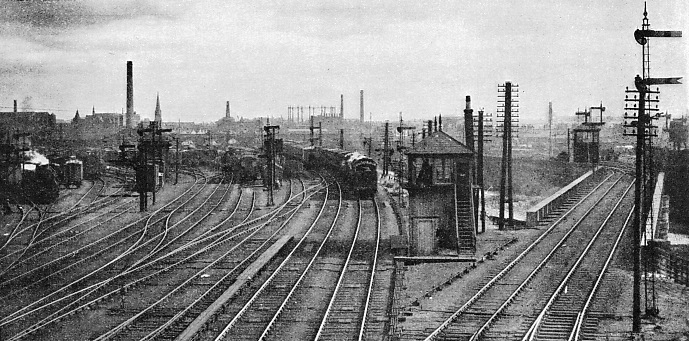
FREIGHT TRAINS rarely pass through the Citadel Station at Carlisle. Goods lines are carried to the west of the passenger station and rejoin the main line three-quarters of a mile to the north. Here are the Viaduct Yard and a section of the goods line at Carlisle.
At 11.45 am arrives the 9.30 am luncheon car express from Glasgow to Liverpool and Manchester. It is particularly important that this train be got away smartly at 11.51 am, or between Penrith and Preston it may delay the “Royal Scot”, which is not far behind. Before the appearance of the latter, however, the “Thames-Clyde Express”, which has left Glasgow (St. Enoch) at 9.30 am, rolls in at 11.55 am, and having exchanged its “Royal Scot” for a “5X” 4-6-0, is due out again on the stroke of midday. At 11.55 also a “slow”, which has been pursuing its weary way round the north-west coast since it left Carnforth at 7 am, arrives at the main down platform, and is followed into the same platform, at 12 noon, by a “semi-fast” from Lancaster.
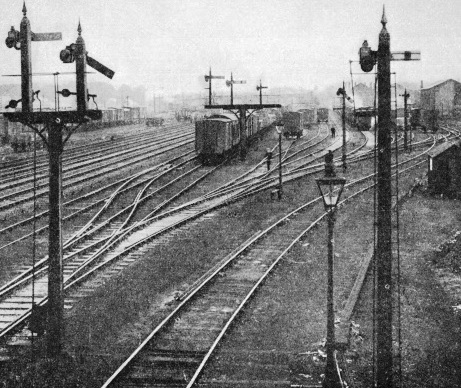
A NETWORK OF LINES is to be seen in the vicinity of Carlisle, where freight trains for all parts of Great Britain are made up. This is a view of some extensive sidings at Petteril Bridge.
And now, at 12.6 pm, the up “Royal Scot”, headed by one of the “Pacifics” of the “Princess Royal” class, draws in from the north. Both Glasgow and Edinburgh portions have left the Scottish cities at 10 am, and have been united at Symington. The crew of the engine is changed here, and at 12.10 pm the “Royal Scot” sets out for London, making what is, for over nine months in the year, the longest regular non-stop run in the world, of 299.1 miles, allowed exactly five and a half hours. Meanwhile a fast LNER train from Newcastle has arrived at 12.8 pm in one of the bays at the south end. Next of the procession of expresses to arrive is one from the south, which has come non-stop from Preston for ninety miles over Shap Summit to Carlisle in 101 minutes. It is an express from Liverpool and Manchester to Glasgow and Edinburgh, arriving at 12.17 pm, and due away again al 12.27 pm. In all probability “5X” 4-6-0’s will work this train into and out of Carlisle. Just before its departure the 10.5 am from Glasgow to Birmingham arrives from the north end, at 12.23 pm, leaving again at 12.28 pm; this is a through “Royal Scot” working from Glasgow to Crewe, and no change of engine takes place. At 12.20 pm, also, a “slow” of the LNER has left one of the south end bays for the Newcastle line.
At 12.32 pm the 6.45 am express from Aberdeen to Euston arrives, probably in charge of a Midland 4-4-0 compound, and three minutes after that a LNER “Pacific” makes its appearance on the “Thames-Forth Express” from Edinburgh to St. Pancras. Both change engines, the former acquiring a “Princess Royal”, and the latter, probably, a Midland compound for the run to Leeds. The Aberdeen express, with its five or six coaches, looks diminutive for a “Pacific”, but the engine is working through to Euston. The train later acquires various through portions and, with quite a heavy load, finishes triumphantly into London with a timing of sixty-one minutes over the 62.8 miles from Blisworth. The Aberdeen train is away at 12.40 pm, and the “Thames-Forth Express” at 12.44 pm. Important express trains have thus run into Carlisle from the north at 11.45 and 11.55 am, 12.6, 12.23, 12.32, and 12.35 pm, and from the south at 12.17 pm, together with “locals” at 11.55, 12.0, 12.8, and a “slow” from Newcastle at 12.39 pm. After this energetic succession in one single hour, a coast train leaves from the Maryport and Carlisle bay for Whitehaven and Barrow at 12.50 pm. At Maryport it will attach a through coach for Euston, to be attached in its turn at Preston to the 3.57 pm express from Carlisle to London - a witness to the extreme leisureliness of transport round this coastal route. At the same moment (12.50) a “semi-fast” is due away from the south end for Newcastle.
At 12.53 pm the morning luncheon car express from Leeds to Glasgow arrives, probably in charge of a “5X” 4-6-0. Two engines are in waiting in the centre of the station - another “5X” or a “Royal Scot” for the Glasgow portion, and a North British type “Atlantic”, with a buffet car and additional coaches for the Edinburgh portion, which is composed of LNER stock. The former leaves at 1 pm, and the latter at 1.3 pm. Last among this particular succession of trains is the 1.12 pm arrival from the south - a luncheon car train from Crewe for Glasgow and Perth, which leaves at 1.18 pm. Thus, in just over an hour and a half, there have been twelve arrivals and thirteen departures.
Comparative peace now descends on Carlisle for two hours, until the next “intensive period”, which begins shortly before half-past three with the arrival off the Midland line of the north-bound “Thames-Forth Express” at 3.21 pm. This is no sooner away - having shed, with its “5X” 4-6-0, a through coach from Nottingham to Glasgow - behind a “Pacific” of the LNER, at 3.26 pm, when the up “Midday Scot”, a very heavy train hauled by the same locomotive through from Glasgow to
Crewe, pulls in at 3.39 pm.
Intensive Activity
The “Midday Scot” is followed, on the opposite side of the station, by the down “Royal Scot” at 3.44pm. The former leaves at 3.43 pm, and the latter, having changed the crew of its “Pacific”, which works through from London to Glasgow, at 3.49 pm. In summer the down “Royal Scot” runs through Carlisle from Euston to Kingmoor, 301.1 miles, in 332 minutes.
At 3.51 pm the 10.5 am express from Aberdeen to Euston is due in at the north end, and four minutes after that, at 3.55 pm, the restaurant car express from Birmingham to Glasgow. They' resume their journeys at 3.57 and 4.0 pm, both having changed engines. Quickly following these, at 4.10 pm, is the combined 2 pm from Edinburgh and Glasgow to Liverpool and Manchester, due out again at 4.15 pm. This is also the booked arrival time of the Midland Division 10 am express from St. Pancras to Glasgow (St. Enoch), which starts away again at 4.20 pm.
From 7.20 to shortly after 9 pm is another busy time, beginning with the arrival from London of the down “Midday Scot” at 7.21 pm, and finishing at 9.5 pm with the exit for the south of the “West Coast Postal” express, which at Carlisle is made up to its full strength of vehicles and staff. Expresses now arrive from Glasgow for the south by both Caledonian and Glasgow and South Western routes, and from Edinburgh for Leeds.
And, finally, there is the extraordinary activity of Carlisle during the night hours. From about midnight onwards it sees little or no cessation. The nightly procession of express passenger and parcels trains leaving Carlisle on every summer night can have few parallels.
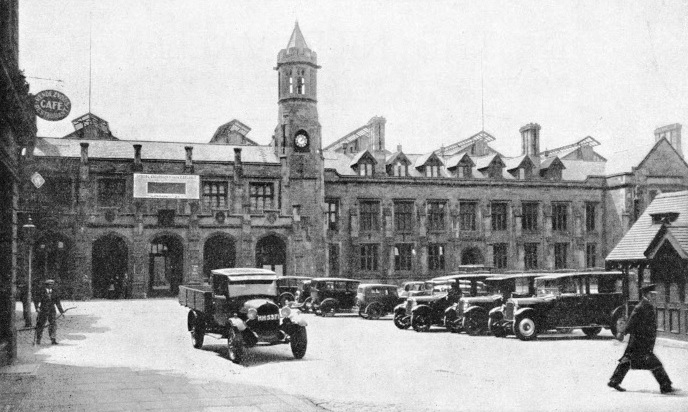
THE FIRST RAILWAY to reach Carlisle was the former North Eastern Railway in 1838. The Lancaster and Carlisle Railway - now part of the West Coast Route - was opened in 1846. In 1859 it was taken over by the LNWR. The lines of the Midland did not arrive until 1875. The Citadel Station, seen above, has to-day three main through platforms and five short bays for local traffic.
You can read more on “The Caledonian Railway”, “Perth General Station” and “The Railways of Caledonia” on this website.








 orse than any of these, however, is the task set to engines of Midland Division trains leaving Carlisle for the south. In the forty-
orse than any of these, however, is the task set to engines of Midland Division trains leaving Carlisle for the south. In the forty-


